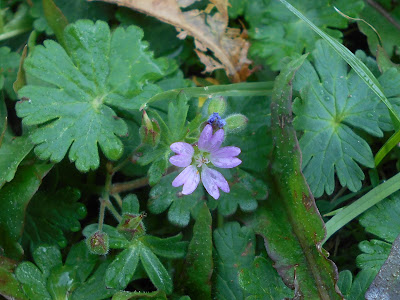Geraniums get their name from geranos, the classical Greek word for a crane and the reference is to the long pointed 'beak' of the carpels. Probably most gardeners grow some geraniums although currently I only grow one - the small but delightful Geranium cinereum 'Ballerina'. (Probably not true G. cinereum but a hybrid.)
 |
Geranium cinereum 'Ballerina' in our front garden at Stefen Hill, Daventry.
28 September, 2018
|
It has typical geranium leaves with the usual palmate shape, 'palmate' because the lobes of the leaves spread out like fingers from the palm of a hand. Small geranium species are common on roadside verges and in lawns and the leaves of Dove's-foot Geranium, G. molle are very familiar.
 |
Geranium molle showing the palmate leaves.
Church Street, Byfield. 3 October, 2018
|
Storksbills are members of the Erodium genus and are very closely related to cranesbills. The best-known species is probably Common Storksbill, Erodium cicutarium, a plant which enjoys dry, rather sandy ground and in Northamptonshire, with its clay soils, it is not 'common' but is only occasionally found. However, given the right habitat it can be abundant. I was both pleased and surprised to find a considerable patch on the grassy roadside verge outside my daughter's house earlier today.
 |
Common Storksbill on the roadside at Timken, Daventry.
28 September, 2018
|
This plant also gets its name from the Greek, in this case from erodios, a heron, and Storksbill also has long pointed fruiting head. A crucial difference between Geranium and Erodium lies in the shape of the leaves for in the case of the latter genus they are not palmate but pinnate, and where the leaves were spreading across a kerbstone their appearance was clear. (An exception to the rule is Erodium pelargonifolium, with palmate leaves.)
A pinnate leaf is a compound structure consisting of leaflets spread along the rachis (leaf stem) and, as most will be aware, comes from the Latin pinna, a feather. Several storksbills are included in plant lists for rock gardens, but are only occasionally used.
 |
Storksbills usually have pinnately compound leaves.
Timken, Daventry. 28 September, 2018
|
In the wild, given its liking for sandy conditions the Common Storksbill is more frequent on or near to the coast. I suspect that the occasional taste of salt when roads are gritted does not come amiss.














































